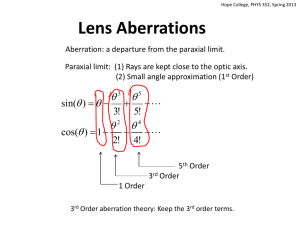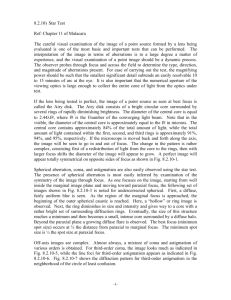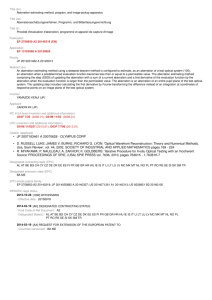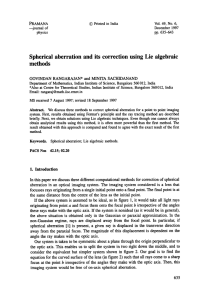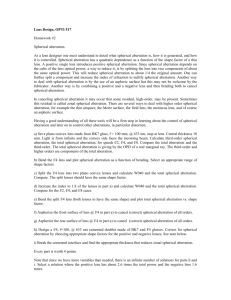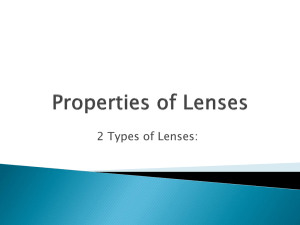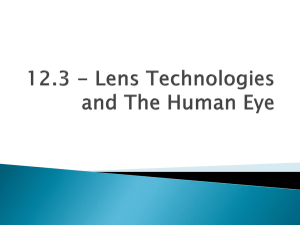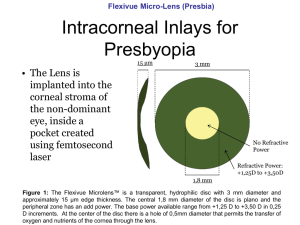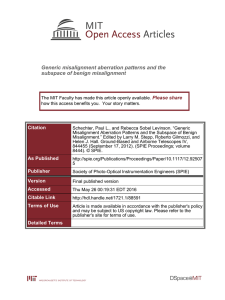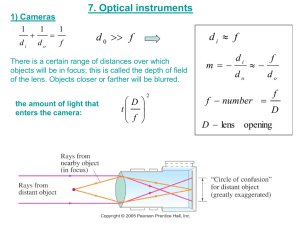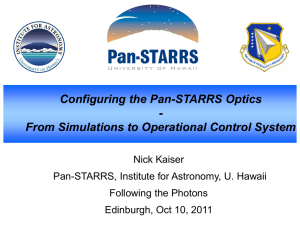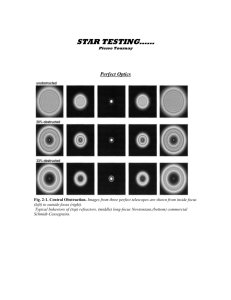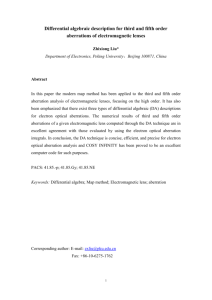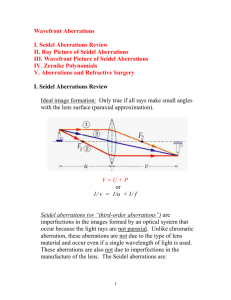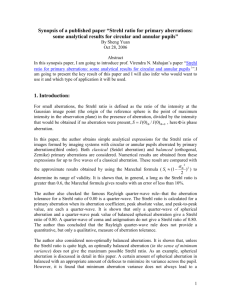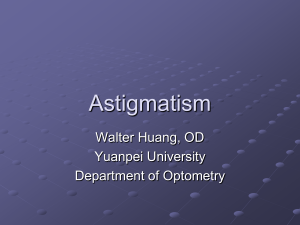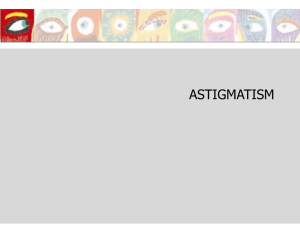Feb 19: 3rd Order Aberrations Lecture Notes
advertisement
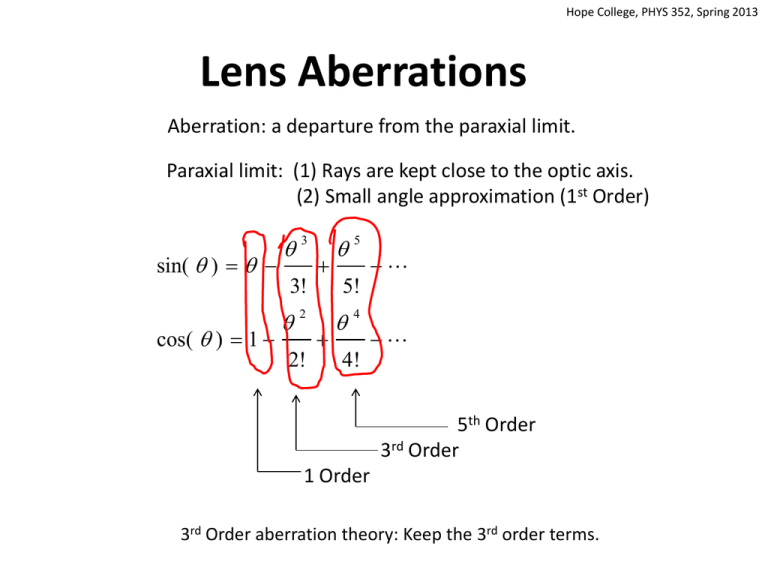
Hope College, PHYS 352, Spring 2013 Lens Aberrations Aberration: a departure from the paraxial limit. Paraxial limit: (1) Rays are kept close to the optic axis. (2) Small angle approximation (1st Order) sin( ) 3 3! cos( ) 1 5 5! 2 2! 4 4! 5th Order 3rd Order 1 Order 3rd Order aberration theory: Keep the 3rd order terms. Hope College, PHYS 352, Spring 2013 Pages 153-159 of Hecht, 4th ed., treats refraction in the paraxial (1st Order) limit. If the 3rd order terms are kept in ℓo and ℓi (p. 154) we find that extended images don’t land on exactly the same focal surface (See Fig. 6.14, p, 254). n1 n2 Q ℓo ℓi Path 1 so si Paraxial Approximation: Path 1 and Path 2 have the same Optical Path Length Quantify the aberration: a(Q)=Path 2 – Path 1 a(Q)=(n1ℓo+n2ℓi)-(n1so+n2si) a=0 means no aberration Hope College, PHYS 352, Spring 2013 The Five Monochromatic Seidel Aberrations n1 ℓo Q yi and yo are paraxial image and object heights. n2 ℓi r yi yo a ( Q ) Ar Br y i cos Cr y i cos Dr y i Ery i cos 4 3 2 2 2 2 2 3 Distortion Curvature of field Astigmatism Spread the Coma image point Spherical aberration (From Pedrotti, 3rd Ed., Section 20.2) Hope College, PHYS 352, Spring 2013 1. Spherical aberration The only aberration that exists even for objects on the optic axis (no yi dependence). a spherical r 4 X Positive SA: The marginal rays converge left of the paraxial image (positive lens) Negative SA: The marginal rays converge right of the paraxial image (negative lens) Homework: Analyze this for a concave mirror. Hope College, PHYS 352, Spring 2013 1. Spherical aberration r2 r1 Minimizing spherical aberration requires using two different radii. n The Coddington shape factor: r2 r1 r2 r1 Spherical aberration is minimized when (Shown in Jenkins & White, Sections 9.4-9.5) 2 n 1 2 n2 s i so si so Homework: For what value of n does a planar convex lens produce a minimum spherical aberration for an object located at infinity? Which side of the lens should the light enter? Hope College, PHYS 352, Spring 2013 2. Coma a coma r y i cos 3 • Depends on yi. e.g. It’s an “off-axis” aberration. • Not symmetrical, which is the origin of the name. screen off-axis object www.telescope-optics.net Negative coma: Marginal rays focus closer to the optic axis. Positive coma: …farther from.. The same lens designs minimize coma & spherical aberration. www.ryokosha.com Figure 6.22a (Hecht, page 260) shows the formation of a comatic image from a series of comatic circles. Hope College, PHYS 352, Spring 2013 3. Astigmatism a r y i cos 2 2 2 Astigmatism: rays from off-axis source do not strike the lens symmetrically (tangential rays versus saggital rays). Tangential rays Saggital rays See Fig. 6.27 (page 263): tangential and saggital rays will fan out and form line images of the point source at two different image surfaces. Hope College, PHYS 352, Spring 2013 Circle of least confusion http://www.olympus-ims.com/en/microscope/terms/classification/ Hope College, PHYS 352, Spring 2013 4. Curvature of Field a r yi 2 2 Curvature of field: Tangential and saggital rays do not form images on the same surface. Very similar to astigmatism, but symmetric about the optic axis. Tangential rays Saggital rays (T left of S: Positive astigmatism) T S Hope College, PHYS 352, Spring 2013 Elimination of astigmatism and curvature of field aberrations Engineer the lens curvatures or spacing so that tangential and saggital surfaces coincide. Two lenses will have a flat P surface if n1f1=-n2f2 Ultimately, the film must conform to P. A focal surface that eliminates astigmatism to 3rd order is called a Petzval surface. Flat P surface – eliminates both astigmatism and curvature of field aberrations. T S P P is always 3x farther from T than S Hope College, PHYS 352, Spring 2013 5. Distortion a ry i cos 3 http://www.olympus-ims.com/en/microscope/terms/classification/ Distortion aberration is caused by non-uniform lateral magnification and is often minimized using aperture stops.
